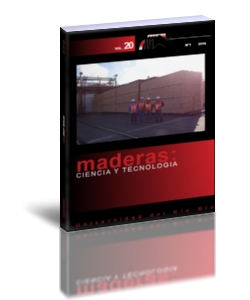Strength grading of turkish black pine structural timber by visual evaluation and nondestructive testing
Keywords:
Longitudinal vibration method, mechanical properties, Pinus nigra, stress wave method, visual strength gradingAbstract
We examined the compatibility between the visual strength grading and the mechanical properties determined by using nondestructive and destructive test methods in Turkish Black Pine structural timbers. Fifty three structural timber were graded with three different visual strength grading standards; TS 1265, DIN 4074, and BS 4978. Dynamic modulus of elasticity was determined by longitudinal vibration (MOEdv) and stress wave (MOEds) test methods. The static modulus of elasticity (MOEs) and the modulus of rupture (MOR) of the timbers were determined in structural size in accordance with EN 408.
The average dynamic and static modulus of elasticity and modulus of rupture values of the timber sorted into best class of all standards were considerably higher than the lower classes. The differences in the modulus of elasticity values between the strength classes were found significant for British and German standards but insignificant for Turkish standard. However the decrease in modulus of rupture values with decreasing grading class was found significant for all standards. Best compliance between the visual grading class and the dynamic or static modulus of elasticity and modulus of rupture was observed for BS 4978. Strong correlations were found between the dynamic modulus of elasticity and static modulus of elasticity and modulus of rupture. Longitudinal vibration method showed better correlation with the static modulus of elasticity and modulus of rupture than stress wave method.
Downloads
References
Baltrušaitis, A.; Pranckevičienė, V. 2003. Strength Grading of the Structural Timber. Materials Science (Medžiagotyra). 9 (3). ISSN 1392–1320.
Bell, E.R.; Peck, E.C.; Krueger, N.T., 1950. Young's modulus of wood determined by a dynamic method. U.S. Forest Products Laboratory Report 1775. WI: U.S. Department of Agriculture, Forest Service. Forest Products Laboratory.
Bucur, V. 2006. Acoustics of Wood. Springer Science & Business Media.
Casado, M.; Acuna, L.; Vecilla, D.; Relea, E.;Basterra, A.; Ramon, G.; Lopez, G. 2010. The influence of size in predicting the elastic modulus of Populus x euramericana timber using vibration techniques. Structures and Architecture – Cruz (Ed.). Taylor & Francis Group, London. ISBN 978-0-415-49249-2.
Divós, F.; Tanaka, T. 2005. Relation between static and dynamic modulus of elasticity of wood. Acta Silv Lign Hung 1:105-110.
Divós, F.; Kiss, F.S. 2010. Strength Grading of Structural Lumber by Portable Lumber Grading - effect of knots. ‘The Future of Quality Control for Wood & Wood Products’. 4-7th May 2010. Edinburgh, The Final Conference of COST Action (Volume 53).
EN 408. 2010. Timber Structures - Structural timber and glued laminated timber - Determination of some physical and mechanical properties, European Standard.
EN 13183-2. 2002. Moisture content of a piece of sawn timber - Part 2: Estimation by electrical resistance method. European Standard.
Fakopp Enterprise. 2002. Portable Lumber Grader Software and Hardware Guide. http://www.fakopp.com/site/downloads/PLG_Guide.pdf.
Fukada, E. 1950. The vibrational properties of wood. Journal of the Physical Society of Japan 5:321-327.
Gerhards, C.C. 1982. Effect of Knots on Stress Waves in Lumber. USDA Forest Service. FPL 384. Madiosun, WI: U.S.
Green, D.W.; Shelley, B.E. 2012. Guidelines For Assigning Allowable Properties To Visually Graded Foreign Species Based On Test Data From Full Sized Specimens. USDA Forest Service. Forest Products Laboratory & West Coast Lumber Inspection Bureau.
Inés, P.; Palacios, C.; Yoza, L.; Mallque, M.; Kian, J. 2011. Elasticity modulus in Peruvian tropical woods using nondestructive techniques - preliminary study. 17th Symposium Nondestructive Testing of Wood. Vol. 1. Sopron, Hungary. Proceedings: 469–475.
Iniguez, G.; Arriaga, F.; Bobadilla, I.; Esteban, M. 2008. Grading by non-destructive techniques and assessment of the mechanical properties of large cross section coniferous sawn timber for structural use. In 10th World Conference on Timber Engineering.
James, W.L. 1964. Vibration, static strength and elastic properties of clear Douglas-fir at various levels of moisture content. Forest Products Journal 14(9): 409-413.
Jayne, B.A. 1959. Vibrational properties of wood as indices of quality. Forest Products Journal 9(11): 413-416.
Kitazawa, G. 1950. Nondestructive testing for forest products. Proceedings: Forest Products Research Society 4:191-197
Leicester, R.H. 2004. Grading for structural timber. Progress in Structural Engineering and Materials 6(2): 69-78.
Matsumoto, I. 1962. Studies on the dynamic modulus E and logarithmic decrement of wood by transverse vibrations. Bull. of the Kyushu University Forests, 36, Fukuoka, Japan.
Pellerin, R.F. 1965. A vibrational approach to nondestructive testing of structural lumber. Forest Products Journal 15(3): 93-101.
Piazza, M.; Riggio, M. 2008. Visual strength - grading and NDT of timber in traditional structures. Journal of Building Appraisal 3: 267 – 296. doi: 10.1057/jba.2008.4.
Ross, R.J.; Pellerin, R.F. 1994. Nondestructive testing for assessing wood members in structures: A review. U.S. Department of Agriculture. Forest Products Laboratory. Technical Report: 70, Madison. 42 p.
Vega, A.; Guaita, M.; Dieste, A.; Majada, J.; Fernandez, I.; Bano, V. 2011. Evaluation of the influence of visual parameters on wave transmission velocity in sawn chestnut timber. In Proceedings 17th International Nondestructive Testing And Evaluation Of Wood Symposium, September 14-16, Hungary.
Wang, S.Y.; Chen, J.H.; Tsai, M.J.; Lin, C.J.; Yang, T.H. 2008. Grading of softwood lumber using non-destructive techniques. Journal of Materials Processing Technology 208:149–158.
Wang, X. 2008. Effects of size and moisture on stress wave E-rating of structural lumber. USDA Forest Products Laboratory, Madison, WI: U.S.
Wang, X.; Carter, P. 2015. Acoustic Assessment of Wood Quality in Trees and Logs. Nondestructive Evaluation of Wood 238: 87.

































